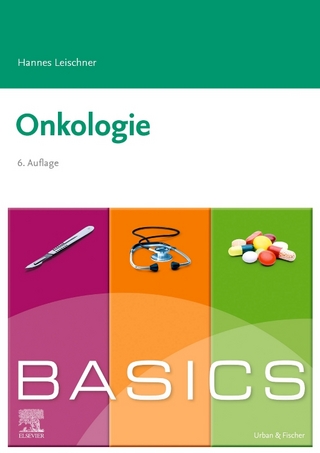
Translational Radiation Oncology
Academic Press Inc (Verlag)
978-0-323-88423-5 (ISBN)
It is a valuable resource for researchers, oncologists and members of biomedical field who want to understand more about translational research applied to the field of radiation oncology. Translational medicine serves as an indispensable tool in grant writing and funding efforts, so understanding how to apply its principles to research is necessary to guarantee that results will be impactful to patients.
Jeff Bakal PhD, P.Stat. is the Program Director for Provincial Research Data Services at Alberta Health Services which operates the Alberta Strategy for Patient Oriented Research (SPOR) data platform and Health Service Statistical & Analytics Methods teams. He has over 10 years of experience working with Health Services data and Randomized Clinical Trials. He completed his PhD jointly with the Department of Mathematics and Statistics and the School of Physical Health and Education at Queen's University. He has worked on the methodology and analysis of several international studies in business strategy, ophthalmology, cardiology, geriatric medicine and the analysis of kinematic data resulting in several peer reviewed articles and conference presentations. His current interests are in developing statistical methodology for time-to-event data and the development of classification tools to assist in patient decision making processes. Daniel Kim works in Radiation Oncology at the Inova Schar Cancer Institute, Fairfax, VA, USA. David E. Wazer, MD, is Professor and Chairman of the Department of Radiation Oncology at Brown University. He is radiation oncologist-in-chief at Rhode Island Hospital, the Miriam Hospital, Newport Hospital, and Women and Infants Hospital. He serves as Director of the Lifespan Cancer Institute. Dr. Wazer’s current areas of clinical research include the study of the efficacy, toxicity, and cost/utility analysis of image-guided radiation therapy, proton beam radiotherapy, partial breast irradiation, and brachytherapy. He is actively involved in the development of clinical trials for cancers of the breast, skin, GI tract, and lung. He is also actively engaged in multiple initiatives to promote and advance oncology care in the developing world. Adam E. M. Eltorai, MD, PhD completed his graduate studies in Biomedical Engineering and Biotechnology along with his medical degree from Brown University. His work has spanned the translational spectrum with a focus on medical technology innovation and development. Dr. Eltorai has published numerous articles and books.
INTRODUCTION 1. Introduction; 2. Translational Process; 3. Scientific Method; 4. Basic Research
PRE-CLINCIAL: DISCOVERY AND DEVELOPMENT 5. Overview of Preclinical Research; 6. What problem are you Solving?; 7. Types of Interventions; 8. Drug discovery; 9. Drug Testing; 10. Device Discovery and Prototyping; 11. Device Testing; 12. Diagnostic Discovery; 13. Diagnostic Testing; 14. Procedural Technique Development; 15. Behavioral Intervention; 16. Artificial Intelligence
CLINICAL: FUNDAMENTALS 17. Introduction to clinical research: What is it? Why is it needed?; 18. The question: Types of research questions and how to develop them; 19. Study population: Who and why them?; 20. Outcome measurements: What data is being collected and why?; 21. Optimizing the Question: Balancing Significance and Feasibility; 22. Statistical Efficiency in Study Design
STATISTICAL PRINCIPLES 23. Basic statistical principles; 24. Distributions; 25. Hypotheses and error types; 26. Power; 27. Regression; 28. Continuous variable analyses: t-test, Man Whitney, Wilcoxin rank; 29. Categorical variable analyses: Chi-square, fisher exact, Mantel hanzel; 30. Analysis of variance; 31. Correlation; 32. Biases; 33. Basic science statistics; 34. Sample Size; 35. Statistical Software
CLINICAL: STUDY TYPES 36. Design principles: Hierarchy of study types; 37. Case series: Design, measures, classic example; 38. Case-control study: Design, measures, classic example; 39. Cohort study: Design, measures, classic example; 40. Cross-section study: Design, measures, classic example; 41. Longitudinal Study: Design, Measures, Classic Example; 42. Meta-analysis: Design, measures, real-world examples; 43. Cost-effectiveness study: Design, measures, classic example; 44. Diagnostic test evaluation: Design, measures, classic example; 45. Reliability study: Design, measures, classic example; 46. Database studies; 47. Surveys and questionnaires: Design, measures, classic example; 48. Qualitative methods and mixed methods; 49. Visual analytics: design, measures, classic example
CLINICAL TRIALS 50. Randomized control: Design, measures, classic example; 51. Nonrandomized control: Design, measures, classic example; 52. Historical control: Design, measures, classic example; 53. Cross-over: Design, measures, classic example; 54. Factorial design: Design, measures, classic example; 55. Large, pragmatic: Design, measures, classic example; 56. Equivalence and noninferiority: Design, measures, classic example; 57. Adaptive: Design, measures, classic example; 58. Randomization: Fixed or adaptive procedures; 59. Blinding: Who and how?; 60. Multicenter considerations; 61. Phase 0 Trials: Window of Opportunity; 62. Registries; 63. Phases of Clinical Trials; 64. IDEAL Framework
CLINICAL: PREPARATION 65. Patient Perspectives; 66. Ethics and review boards; 67. Regulatory considerations for new drugs and devices; 68. Funding approaches; 69. Conflicts of Interest; 70. Subject recruitment; 71. Data management; 72. Quality control; 73. Special Populations; 74. Report Forms: Harm and Quality of Life; 75. Subject adherence; 76. Survival analysis
REGULATORY BASICS 77. FDA overview; 78. IND; 79. New drug application; 80. Devices; 81. Radiation-Emitting Electronic Products; 82. Orphan Drugs; 83. Biologics; 84. Combination Products; 85. CMC and GxP; 86. Post-Market Drug Safety Monitoring; 87. Post-Market Device Safety Monitoring
CLINICAL IMPLEMENTATION 88. Implementation Research; 89. Design and Analysis; 90. Mixed-Methods Research; 91. Guideline Development; 92. Cooperative Group Research; 93. Digital Health
PUBLIC HEALTH 94. Public Health; 95. Epidemiology; 96. Factors; 97. Good Questions; 98. Population- and Environmental-Specific Considerations; 99. Law, Policy, and Ethics; 100. Public Health Institutions and Systems; 101. DEI (Diversity, equity, inclusion)
PRACTICAL RESOURCES102. Ethics in Scientific Publishing; 103. Presenting Data; 104. Manuscript Preparation; 105. Promoting Research; 106. Social Media; 107. Quality Improvement; 108. Education to translate research into practice; 109. Team Science and Building a Team; 110. Patent Basics; 111. Venture Pathways; 112. SBIR/STTR; 113. Sample Forms and Templates
| Erscheinungsdatum | 12.08.2023 |
|---|---|
| Reihe/Serie | Handbook for Designing and Conducting Clinical and Translational Research |
| Zusatzinfo | 150 illustrations (50 in full color); Illustrations |
| Verlagsort | Oxford |
| Sprache | englisch |
| Maße | 216 x 276 mm |
| Gewicht | 1950 g |
| Themenwelt | Medizin / Pharmazie ► Medizinische Fachgebiete ► Onkologie |
| Naturwissenschaften ► Biologie | |
| ISBN-10 | 0-323-88423-7 / 0323884237 |
| ISBN-13 | 978-0-323-88423-5 / 9780323884235 |
| Zustand | Neuware |
| Haben Sie eine Frage zum Produkt? |
aus dem Bereich


